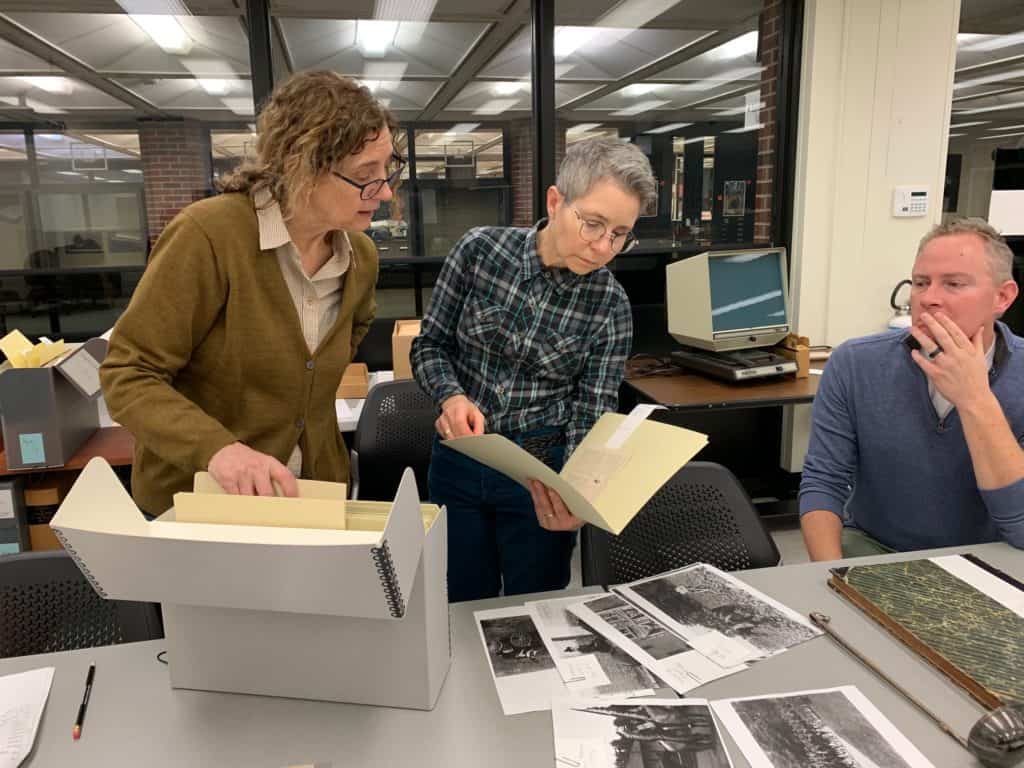Guidelines
Priorities
- Top consideration will be given to exhibition ideas with well-defined themes, learning objectives, and potential for community and curricular impact that showcase collections from the University of Iowa Libraries.
- Potential curators must spend time reviewing relevant collections in the University of Iowa Libraries to ensure ample item options for a compelling display. Examples of relevant collections and specific items should be included in the finalist proposal, but it would be beneficial to include some examples in the initial statement of interest.
- University of Iowa Libraries collections must be the primary sources from which display items are drawn. Note: As needed, these items may be shown alongside a small selection of approved items loaned from other institutions, campus GLAM (galleries, libraries, archives, museums) partners, or collectors.
- There must be potential for the exhibition to grow partnerships across campus and the community.
Audience
- The Main Library Gallery is a learning space both for students and the general public. Consideration should be given to how undergraduates, graduate students, and community demographics may respond to an exhibition topic.
Selection
- Four finalist exhibition proposals will be accepted following the conclusion of round two.
- Please review the section below about the submission process.
Curator expectations
A guest curator in the Main Library Gallery is someone who assembles a research-based story narrative for the exhibition medium. This storytelling is enhanced by a selection of compelling items from the Libraries collections. In addition to researching for and curating items for the exhibition, individuals in this role must expect to serve as subject matter experts throughout the duration of an exhibit. This includes some exhibit-related class interaction or instruction, public programming, and serving as a content consultant for exhibit-related videos, social media and blog posts, and other engagement projects being created by Libraries staff to promote an exhibit. Faculty and staff of the University of Iowa are eligible to serve as curators/co-curators. Multiple curators are required in order to spread out research, production, and public engagement tasks for an exhibit. (Co-curators may also be students and community members if a University of Iowa staff or faculty member serves as lead curator.)
Curating an exhibition is a significant time investment, but the exhibit production process will be guided by Gallery staff and a reasonable production calendar. A professional designer, preparator, conservator, and exhibition and engagement coordinator will ensure success.
- Curators are expected to commit to their exhibit project from beginning to end, including completing key curatorial tasks such as research, item selection, narrative text writing, and participating in public events.
- Curators are expected to meet all agreed-upon deadlines.
- Exhibit production staff will exercise executive authority in design and item display.
- Curators must receive approval from their DEO or direct supervisor prior to beginning the proposal process. A letter of approval and recommendation will be required for submissions invited to round two.
- Curators should be prepared to devote approximately 15 months+ to exhibition production and work as a team with co-curators and Libraries exhibition staff.
Example:- ~Nine months of moderate work to plan the exhibition (thorough research, archives visits, narrative outline, item selection, meetings, communication tasks)
- ~Three months of intensive work before opening day (writing exhibit text, editing, approving designs, co-planning exhibit-related events, etc.)
- ~Three–five months of intensive work while the exhibition is open, depending upon the exhibit’s run dates (availability as possible to speak with classes and to give guided tours, talks, and other types of exhibit-related programming as agreed upon during event planning)

The Pull of Horses exhibit co-curators Kim Marra and Mark Anderson selecting materials with help from Janet Weaver, curator of the Iowa Women’s Archives. Photo: Sara Pinkham.
Proposal submission & selection process
- Step I: Potential curators submit an initial statement of interest, after which the Main Library Gallery Exhibition Proposal Review Committee reviews the collected statements. Main Library Gallery Exhibition Proposal Review Committee is made up of several UI Libraries staff members, representatives from the Pentacrest Museums and the Stanley Museum of Art, students and faculty, and an associate university librarian. Strong statements are chosen by this committee for the next step.
- Step II: The initial statements with the strongest themes, highest potential for impact, and a topic with plentiful available materials for display are invited to create and submit a complete exhibition proposal.
- Step III: The committee reviews and selects the most rounded finalist proposals. Top consideration will be given to exhibition ideas with well-defined themes, learning objectives, and potential for community and curricular impact that showcase collections from the University of Iowa Libraries. Four proposals will be accepted, one each for the following time slots: spring 2027, fall 2027, spring 2028, fall 2028.
- Step IV: Approved guest curators begin working with the Gallery’s exhibition and engagement coordinator. A production calendar will be established.
Selection timeline 2025
- April 7: Deadline for statements of interest. The submission form is now closed.
- April 18: First-round decisions are announced. Finalists are invited to write complete proposals.
- July 18: Deadline for finalist exhibition proposals.
- August 4: 2027 – 2028 exhibitions are announced. Four total proposals will be selected for production.
Exhibitions chosen for the Main Library Gallery will be funded by the University of Iowa Libraries, but additional funding procured by curators from other sources is deeply appreciated and should be considered while crafting proposals. Please contact the Main Library Gallery with questions.
